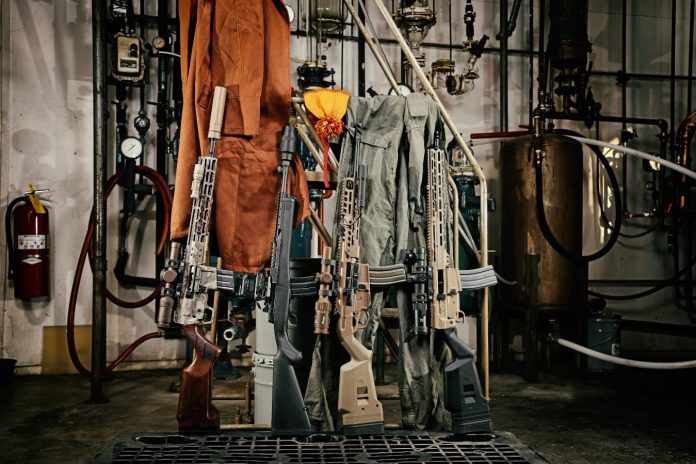The concept of a ranch rifle is generally considered to be a handy, compact, intermediate-caliber rifle, carried around all-day long from dawn to dusk while on a ranch.
Most people probably envision something like the OG ranch rifle, the Ruger Mini-14 — a magazine-fed semi-automatic rifle in 5.56 or 7.62×39 with a traditional stock. Such a rifle is very effective at policing a ranch, protecting livestock, crops, and more by dispatching pests, predators, and game.
While an AR-15 fills the same role very capably, some might prefer the slim profile and feel of a traditionally stocked rifle. Many shooters find a traditional stock to point and handle very naturally and intuitively. When transporting your gun, such as in a scabbard on horseback, a ranch rifle is slimmer from top to bottom than typical pistol-gripped modern sporting rifles.
Or you might like the aesthetics or simply want more variety in your portfolio of blasters. Finally — and more controversially because of the politics — you might live behind the curtain in a state that doesn’t respect the Second Amendment. Such ban states like California and New York restrict ownership of firearms based on arbitrary factors such as the presence of a pistol grip on a magazine-fed semi-automatic rifle.
Therefore, the traditional stock found on ranch-style rifles (and lack of other silly criteria such as flash hiders and vertical grips) place them in the rarefied position of not being classified as a so-called “assault weapon,” often referred to as “featureless” builds.
A refrain we commonly hear about ban states like California from red-blooded Americans in free states is something like, “Screw California! You should move out of that hell hole.” Or they might proclaim, “Do not comply!” While many people are indeed fleeing ban states, many also have generations of families, businesses, farms, jobs, and other things keeping them there. And when you have the well-being of your loved ones at stake, simply ignoring local laws isn’t a great option.
Moreover, states like California and New York are huge components of the economy, infrastructure, and fabric of the United States, and thus have a significant impact on the nation as a whole, whether you like it or not. Thankfully, patriotic residents of those states as well as 2A advocacy groups continue to fight tooth and nail to defend our rights, and it behooves us all to support them.
Let’s be clear, while mainstream media sources regularly paint the fight for the Second Amendment as “expanding gun rights,” it’s no such thing. In fact, we’re just fighting back against decades of laws and regulations that have been chipping away at our Constitutional rights.
And as much as everyone loves to hate on New York, it gave rise to the landmark New York State Rifle & Pistol Association v. Bruen decision, in which the Supreme Court reiterated the plain meaning of the Second Amendment and clarified the framework by which the constitutionality of gun-related legislation needs to be assessed.
This has led to challenges of many other laws across the land that infringe on the Second Amendment.
While the legal and legislative fight continues on unabated, one can optimistically hope that these unconstitutional “assault weapon” bans will be overturned on the basis of the Bruen framework — even as many politicians continue to call for a national ban.
Meanwhile, ranch-style rifles can provide most of the practicality of their free-state equivalents while keeping ban-state residents compliant with current laws. They’re semi-automatic, magazine-fed rifles that can put rounds on target just like any other — which incidentally makes clear the absurdity of these “assault weapon” bans.
We all bristle when our options are restricted by the government, but as far as we’re concerned, the more of these rifles out there with citizens to guard hearth and home the better, even as we look to a future where the modern musket is protected nationally. And don’t forget these are large and highly populated states; the more gun owners in the fold the better.
We’ve already discussed how some shooters might prefer the ergonomics of a traditionally stocked gun, and how they’re slimmer as well. So let’s talk about some potential downsides.
You lose the ability to quickly adjust the length of pull and the option of a folding stock. Overall length may be longer due to the positioning of the firing hand. Safeties typically aren’t as easy to flick on and off, and reloads usually aren’t quite as efficient. You’ll need a cheek riser to use optics, and ergonomics for CQB and unusual positions aren’t as comfortable. We used ADM’s AD-RECON-SL scope mounts to position our scopes as low as possible.
But ranch rifles certainly get the job done, and they do it in style, if not a bit steampunk. Highlighted here are the OG itself, the Mini-14, in modern form, as well as three weapon systems from CMMG, Foxtrot Mike, and SIG Sauer that utilize “bufferless” uppers. They’re entirely self-contained, with recoil springs within the upper, so they don’t require a lower with a receiver extension.
Thus, they allow for folding stocks, no stocks at all, or, as shown here, traditional stocks. Additionally, you can always adapt the uppers to regular AR lowers in the future. Mal and Zoë would approve.
CMMG BR4 DISSENT
SPECS: CMMG BR4 Dissent
- Caliber: 5.56mm, 300BLK, 22ARC, 6mm ARC, 6.5 Grendel, 9mm, 350 Legend
- Barrel length: 14.5, 16.1 inches (tested)
- Overall length: 37.3 inches (as tested)
- Weight: 7.6 pounds
- MSRP: Starting at $1,900
Accessories:
- Atibal X 1-10×30 FFP Plumb Reticle scope – $800
- ADM AD-RECON-SL scope mount – $227
- SureFire M640DFT Pro Turbo Scout Light Tan – $439
CMMG has been manufacturing ARs since 2002, always looking to provide quality at a good price while continually enhancing the platform and supporting a wide variety of calibers. A few years ago, CMMG introduced their bufferless Compact Action in their Dissent line, for use as a pistol or with folding stocks. The Compact Action’s bolt carrier group is shortened so it doesn’t extend past the rear of the upper, with dual guide rods and springs above it. Since that’s where the charging handle usually lives, it’s moved forward to the handguard as a side charger that can be placed on either side.
To adapt their Dissent uppers for use with a traditional stock, CMMG designed a new lower. Think of it as a regular AR lower with the rear stretched out to accommodate a mounting point for a Magpul SGA Remington 870 shotgun stock and the trigger relocated further aft so it’s properly positioned for the stock.
This makes the magazine release unreachable unless you have E.T. fingers, so CMMG added an ambidextrous unit to reload with your support hand. A standard AR safety selector no longer works, so CMMG placed a crossbolt safety at the very end of the lower. This actually works fine, as you can actuate it from one side with your trigger finger and the other with your thumb, though you’ll probably need to shift your grip.
Notably, CMMG has built out an entire family of products, with many caliber options and large-frame and small-frame lowers, called the Br3 and Br4, respectively. The Br3 is offered in 7.62mm, 6.5CM, and 8.6BLK, while the Br4 comes in 5.56mm, 300BLK, 22ARC, 6mm ARC, 6.5 Grendel, 9mm, and 350 Legend. There are various barrel lengths and some non-threaded options, plus your choice of seven different Cerakote colors.
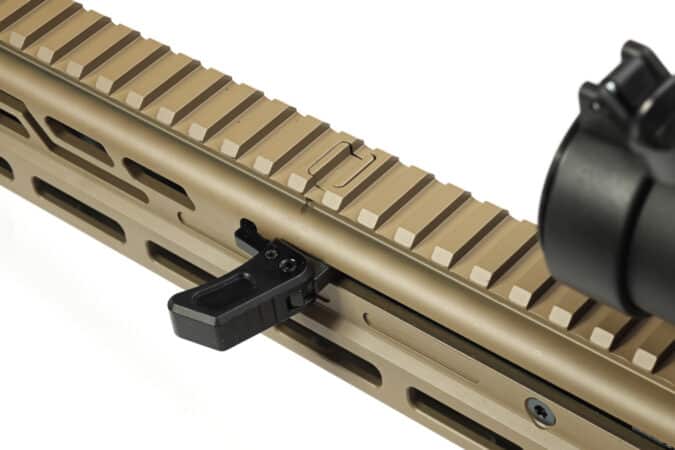
Our sample is a Br3 in 5.56mm with a 16.1-inch 1:7-twist 4140 barrel with a 15-inch M-Lok handguard. The gas block is adjustable; you’ll need a long 3/32-inch Allen key to reach it. The muzzle brake and trigger are from CMMG’s own premium Zeroed line. The single-stage trigger has a longer linkage for the relocated trigger shoe, but it breaks relatively cleanly with some creep at 3.75 pounds.
Off the bench, the CMMG delivered solid performance, though it wasn’t as accurate as the Foxtrot Mike and SIG. American Eagle XM 55-grain printed a 3.2 MOA five-shot group at an average of 2,927 fps. ADI 69-grain SMKs did 2.4 MOA at 2,615 fps, and Igman 55-grain FMJ delivered 2.2 MOA at 2,904 fps. Federal Gold Medal Center Strike 77-grain OTM did the best with a 1.8 MOA group at 2,416 fps.
On the range, the CMMG handled very well with good ergonomics, only lacking an ambidextrous bolt catch. Between the muzzle brake and the adjustable gas block, it shoots flat with good return on recoil. It was completely reliable with no malfunctions or issues.
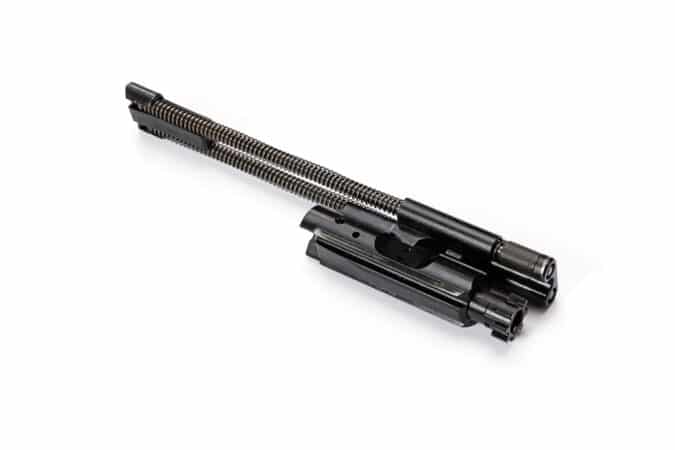
The same held true for CMMG’s 9mm upper that we also tested on the Br3 lower, as it feeds from a magazine with the same outer footprint as a regular STANAG magazine. This upper features CMMG’s radial delayed blowback system, so it was reliable with various different loads and had a nicer recoil impulse than typical straight blowback 9mm ARs.
The CMMG Br4 Dissent has great attention to detail, with minimal compromises for the ranch rifle format, though it’s on the heavier side. We also salute CMMG for the wide range of options and calibers they’ve fielded, including a large frame version. It’s a great option to get a ranch rifle in the exact — or multiple — chambering you’re seeking.
FOXTROT MIKE RANCH RIFLE
SPECS: Foxtrot Mike Ranch Rifle
- Caliber: .223 Wylde
- Barrel length: 16 inches
- Overall length: 37.5 inches
- Weight: 6.2 pounds
- MSRP: Starting at $949 ($1,449 as tested without Cerakote)
Accessories:
- Vortex Razor HD Gen II-E 1-6×24 scope – $2,400
- ADM AD-RECON-SL scope mount – $227
- JP Enterprises JPAMC ambidextrous magazine catch – $90
- SureFire Mini Scout Light Pro – $369
- Rugged Suppressors Razor762 – $894
Foxtrot Mike aims to create innovative firearms at reasonable prices. Their second- generation uppers are bufferless, with dual nested springs and a recoil rod that threads through a counterbore in the abbreviated BCG’s carrier key and seats into the rear of the forward charging handle rod.
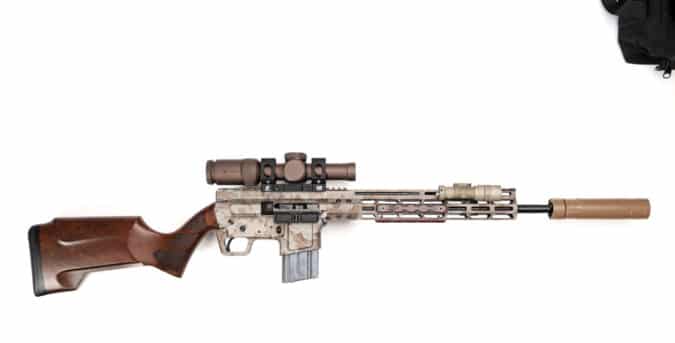
They then designed a ranch-style lower that extends further back to take a Remington 870 stock with the trigger guard brought back within reach. The safety is a reversible cross-bolt unit, nicely positioned to deactivate it with your trigger finger but inconveniently far forward on the other side to put back on safe.
Unfortunately, the gun doesn’t come with ambidextrous controls; we can forgive the bolt catch but an ambi mag release is a must have on a rifle like this. We added JP Enterprises’ excellent unit, which was a cinch to install and works great for reloading with your support hand. Foxtrot Mike should ship them this way.
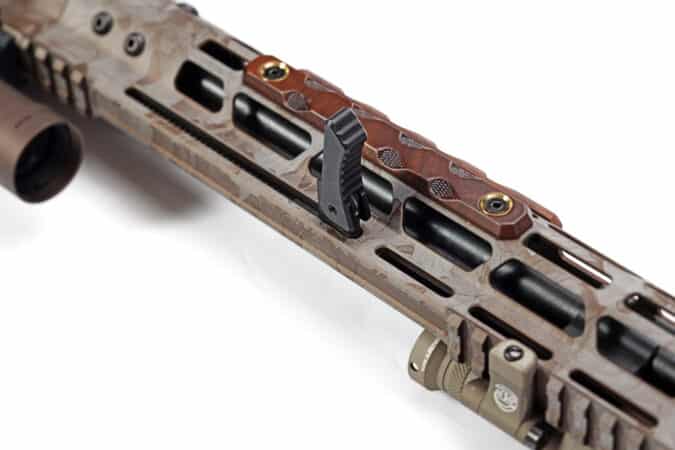
The trigger shoe itself is peculiar — it’s basically upside down, pivoting on the bottom rather than the top. You grow accustomed to it, but it feels quite odd for a while. Our sample has an optional Hiperfire trigger, which breaks cleanly at 3.5 pounds with a little creep. Given the online chatter we’ve read complaining about the heavy standard trigger, the $250 premium for the Hiperfire is worthwhile.
Foxtrot Mike’s manufacturing techniques and considerations are as interesting as their firearm designs. For instance, they make their own barrels and are extremely meticulous. They machine flats on the barrel at the muzzle and the rear; the one in front helps you easily service the muzzle device and the one in the rear ensures the barrel extension can be installed in the factory to an exact torque specification.
Barrels are made from premium 41V50, vacuum stress relieved, and melonited with a burnished chamber. Foxtrot also replaces its tooling on a strict schedule to ensure consistency, with extensive QA performed on every barrel. Additionally, a taper lock barrel nut ensures concentricity.
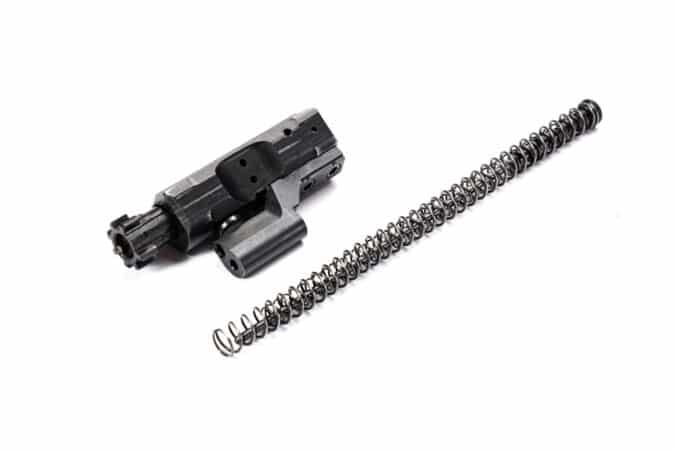
Indeed, Foxtrot Mike’s OCD paid dividends at the range, as it delivered impressive accuracy in our testing. American Eagle grouped five shots in 1.8 MOA at 2,976 fps, while Federal Gold Medal Center Strike 77-grain OTM gave us 1.7 MOA at 2,454 fps. Igman 55-grain FMJ printed 1.5 MOA at 3,000 fps, and ADI 69-grain SMK achieved 0.7 MOA at 2,650 fps. Bravo, especially from a 6.2-pound ranch rifle.
The rifle is very light and handles very well. It has a very mild recoil impulse, but we found the four-port muzzle brake to push the gun downward excessively. We replaced it with a Rugged Suppressors muzzle brake, making it silencer-friendly.
Working the action is stiffer than the other rifles here, though it gets better with use. On our first range trip, we experienced some feeding issues, but determined it was a bad magazine that caused the same problem with all the rifles we brought out that day. Besides that, the rifle functioned 100 percent.
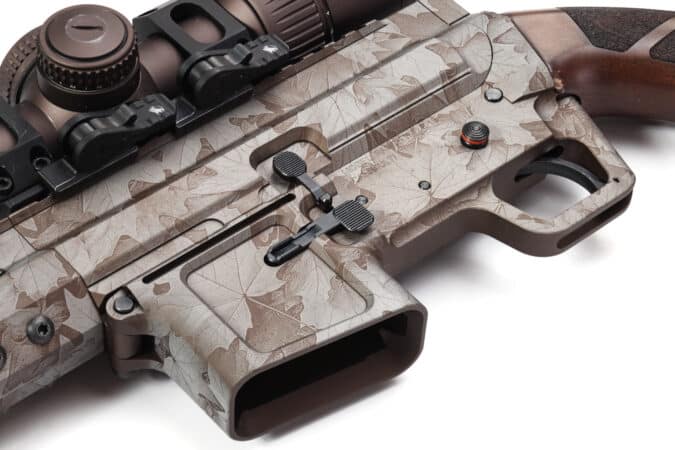
Our sample came with the optional sexy Woox wood furniture, partial top rail delete, and a sweet Cerakote paint job that’s no longer listed on the website. You needn’t get that fancy. Even with the premium for the Hiperfire trigger and extra budget for an ambi mag release, Foxtrot Mike’s Ranch Rifle is quite a bit more affordable than the others. Despite some quirks, combined with its light weight, impressive accuracy, and great handling, this makes it very appealing.
SIG MCX REGULATOR
SPECS: SIG Sauer MCX Regulator
- Caliber: 5.56mm, 7.62x39mm
- Barrel length: 16 inches
- Overall length: 38 inches
- Weight: 7.7 pounds
- MSRP: $2,800
Accessories:
- SIG Sauer Tango 6T 1-6x24mm scope with SFP Hellfire reticle – $1,500
- SIG Sauer Alpha2 scope mount – $100
- SIG Sauer Foxtrot-MSR full-size weapon light – $200
Unlike the other two direct-impingement guns, the SIG MCX Regulator is topped by SIG’s battle-tested, short-stroke gas-piston MCX upper. The MCX upper is already self-contained, so it works as-is on SIG’s new ranch-style lower.
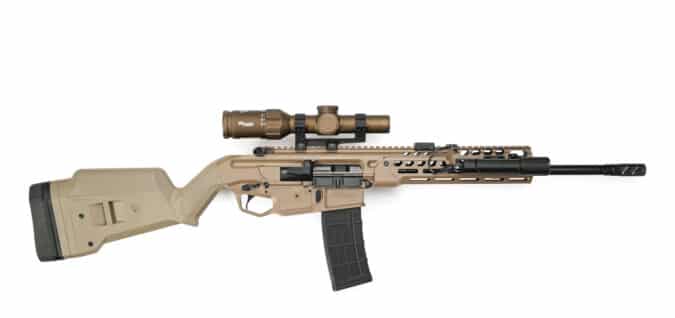
It has a level of refinement that you can only expect from a Goliath like SIG. Like the others, the lower is stretched to accommodate a traditional stock (Mossberg 500 in this case), but it’s carefully crafted with several niceties.
The bottom of the lower between the magwell and the trigger guard is machined into an integrated ARCA rail so you can clamp in to a tripod. The trigger guard is canted upward and the trigger shoe contoured to match, placing it higher and making it more comfortable to access when gripping the traditional stock. The lower is longer than the CMMG and Foxtrot Mike, providing an organic, comfortable rear contour as well as additional space to work the MCX’s rear charging handle.
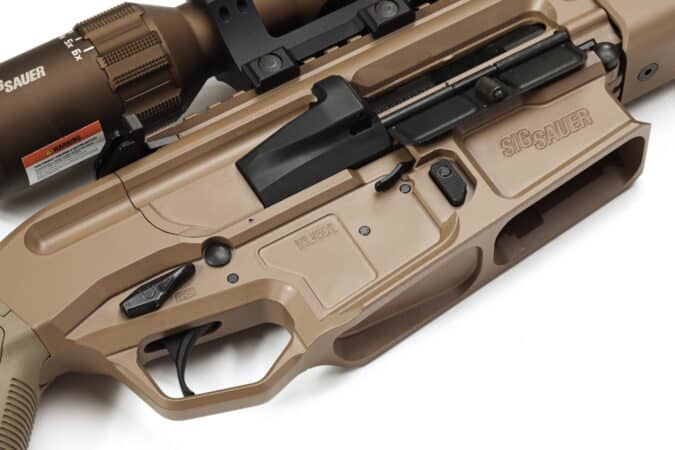
But the most brilliant aspect is the Regulator’s safety selector. SIG engineered an ambidextrous safety that’s wonderful to use with your trigger finger and arguably better than a 45-degree selector on a regular AR, already widely considered to be the pinnacle of rifle ergonomics. Plus, it features the same ambidextrous magazine and bolt controls you’d find on other late-model MCX-SPEARs.
As we mentioned in our MCX-SPEAR review on page 54, we’re accustomed to seeing around 1.5 MOA from this platform. Our Regulator did even better than this. Off the bench, American Eagle XM 55-grain FMJ put five shots in 2.5 MOA at an average of 2,906 fps. ADI 69-grain SMK did 1.6 MOA at 2,610 fps. Igman 55-grain FMJ cranked it up to 1.3 MOA at 2,944 fps, and Federal Gold Medal Center Strike 77-grain OTM brought it home with 1.2 MOA at 2,439 fps. We had one failure to feed in the second magazine we put through the gun, then never had another issue after that.
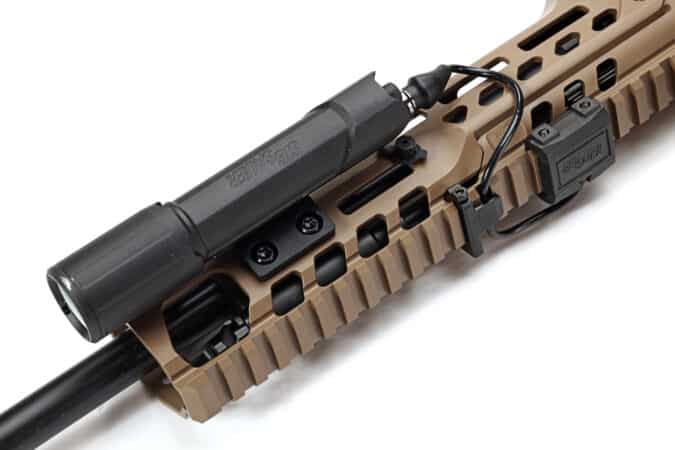
SIG calls the trigger a two-stage match trigger. We’d call it a nearly 6-pound two-stage trigger with a fair amount of creep; it’s better than a standard USGI trigger but not as good as other SIG match triggers we’ve had. It gets the job done.
We kitted ours out with SIG’s new 33,000 candela Foxtrot-MSR weapon light and Tango 6T 1-6x scope with the bright Hellfire reticle. The rifle is accurate, reliable, and shoots soft and flat.
Ergonomics are great, especially the safety as a real standout for serious tactical use where you’re flicking it on and off, though it’s heavier than the others and the rear charging handle feels cramped.
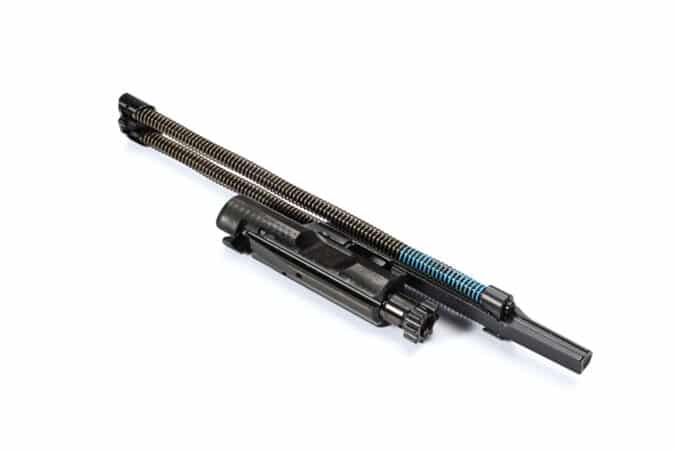
Overall, this is truth in advertising — the MCX Regulator is everything you love about the MCX, just with a traditional buttstock. Your wallet might hate you, but you could easily take this rifle to war, much less tote it around a ranch.
RUGER MINI-14
SPECS: RugerMini-14
- Caliber: 5.56mm
- Barrel length: 16.1, 18.5 inches
- Overall length: 35 inches (as tested)
- Weight: 6.8 pounds (as tested with shortened barrel and Samson rail)
- MSRP: $1,259
Accessories:
- Samson Hannibal Rail – $145
- Atibal E2 Enclosed Red Dot – $325
- GG&G Mini-14 Ranch Scope Mount Picatinny Rail – $52
- PWS FRC 3-port compensator – $100
- Silencer Central Speed K suppressor – $1,199
Ruger introduced the Mini-14 in 1973, and we’d be remiss if we didn’t include it in this article. As its name suggests, it was positioned as a smaller version of the M14 service rifle, though its fixed piston gas system is actually more like an M1 Garand.
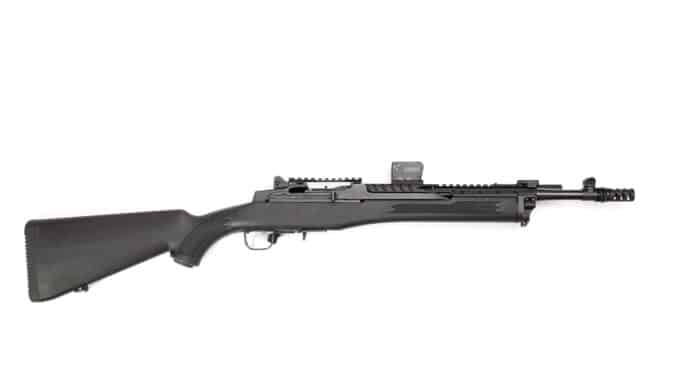
Ruger has been manufacturing them ever since, updating them over the years and releasing and discontinuing various models and calibers. Today, Ruger offers traditional Mini-14 ranch rifles with 18.5-inch barrels, tactical models with 16- and 18.5-inch barrels as well as optional folding stocks, and Mini-30s chambered in 7.62x39mm.
Our sample here is a current production standard blued ranch rifle. It comes from the factory with an 18.5-inch, cold hammer forged, non-threaded barrel and optional synthetic stock. As is, it’s legal just about everywhere.
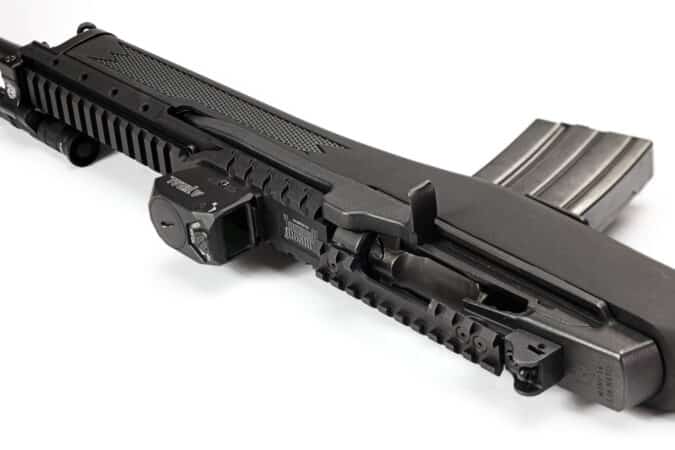
To further modernize our rifle, we sent it off to Wright Armory in Arizona to work their magic. They cut, crowned, and threaded the barrel, then relocated the front sight. They pinned and welded a Primary Weapon Systems FRC Plan B-compatible muzzle brake so the overall length was an NFA-friendly 16.1 inches. Finally, they installed Samson’s Hannibal rail to provide a top Pic rail over the handguard and mounting for accessories and a forward red dot.
One important upgrade with later Mini-14s are the tapped integral scope mounts; you can attach scope rings or Ruger’s Picatinny rail as shown. This is much improved over the previous scalloped scope bases that you had to fiddle with to align your optics. However, if you have an older Mini-14, GG&G makes an affordable Picatinny rail that’ll mount to them.
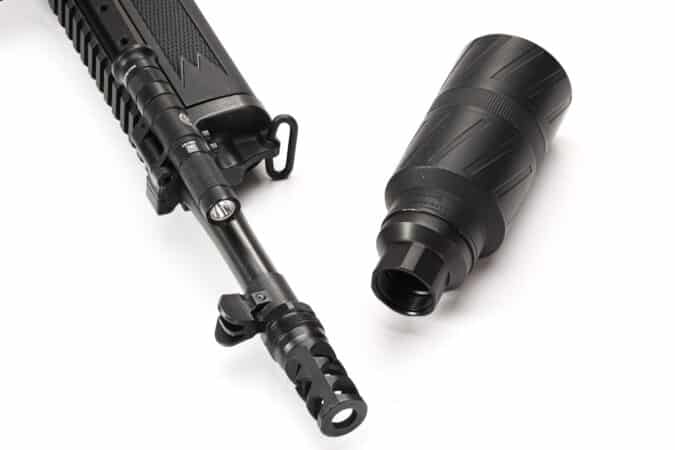
While Mini-14s aren’t known for pinpoint accuracy, our sample was still a 3 MOA gun with the right ammo, which is fine for the intended purpose. American Eagle XM 55-grain FMJ had the largest five-shot groups at 6 MOA, with an average velocity of 2,814 fps. ADI 69-grain SMK gave us 3.7 MOA at 2,521 fps. Meanwhile, Igman 55-grain FMJ tightened it up to 3.3 MOA at 2,802 fps. Federal Gold Medal Center Strike 77-grain OTM topped the ranking with 3 MOA at 2,320 fps. The trigger broke at 5 pounds with some creep.
Mini-14s are known for chucking brass into the next zip code, and ours was no exception, making quick work of every magazine we ran through it with no malfunctions of any kind. The lightweight rifle pointed very naturally and snapped quickly between targets. While it didn’t shoot as flat as the other guns, the muzzle brake helped settle it down and it was easy to hammer multiple-shot strings.
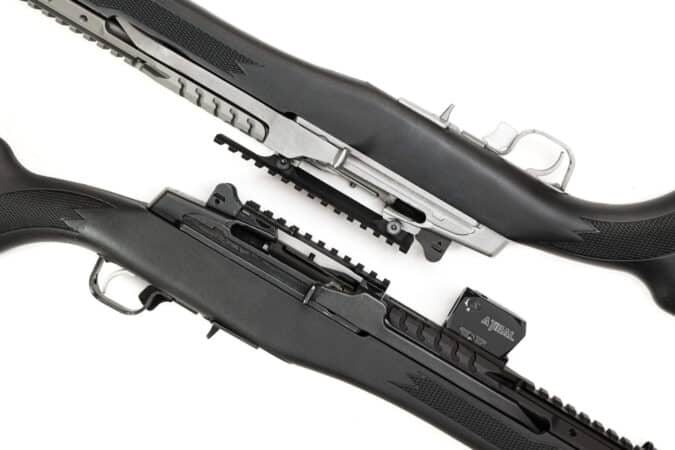
As the Mini-14 is over 50 years old, it should be no surprise that modern platforms — including Ruger’s own ARs — outperform the Mini-14. But not only are Mini-14s enticingly nostalgic, they’re downright fun and enjoyable to shoot. Our tricked-out version accepts a suppressor and whatever accessories you want to add, just like any other modern rifle. The Mini-14 is light, nimble, reliable, and svelte. All these decades later, it remains the archetype of what a handy ranch rifle is.
MORE FOR THE RANGE

NEXT STEP: Download Your Free Target Pack from RECOIL
For years, RECOIL magazine has treated its readers to a full-size (sometimes full color!) shooting target tucked into each big issue. Now we’ve compiled over 50 of our most popular targets into this one digital PDF download. From handgun drills to AR-15 practice, these 50+ targets have you covered. Print off as many as you like (ammo not included).
Get your pack of 50 Print-at-Home targets when you subscribe to the RECOIL email newsletter. We’ll send you weekly updates on guns, gear, industry news, and special offers from leading manufacturers – your guide to the firearms lifestyle.
You want this. Trust Us.
Read the full article here


